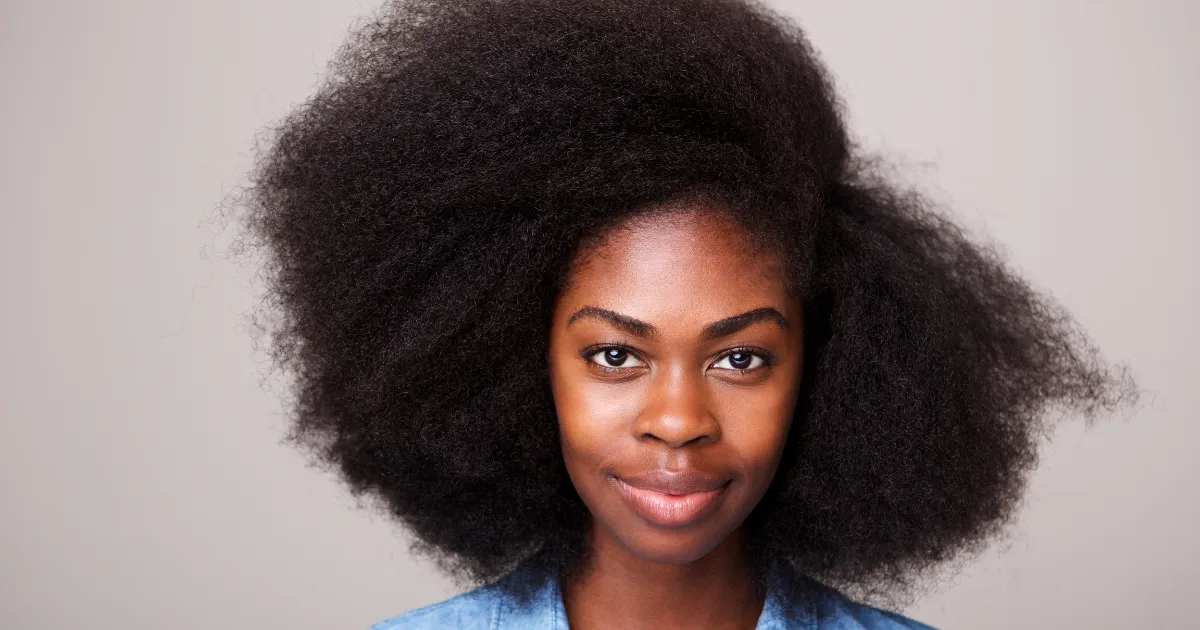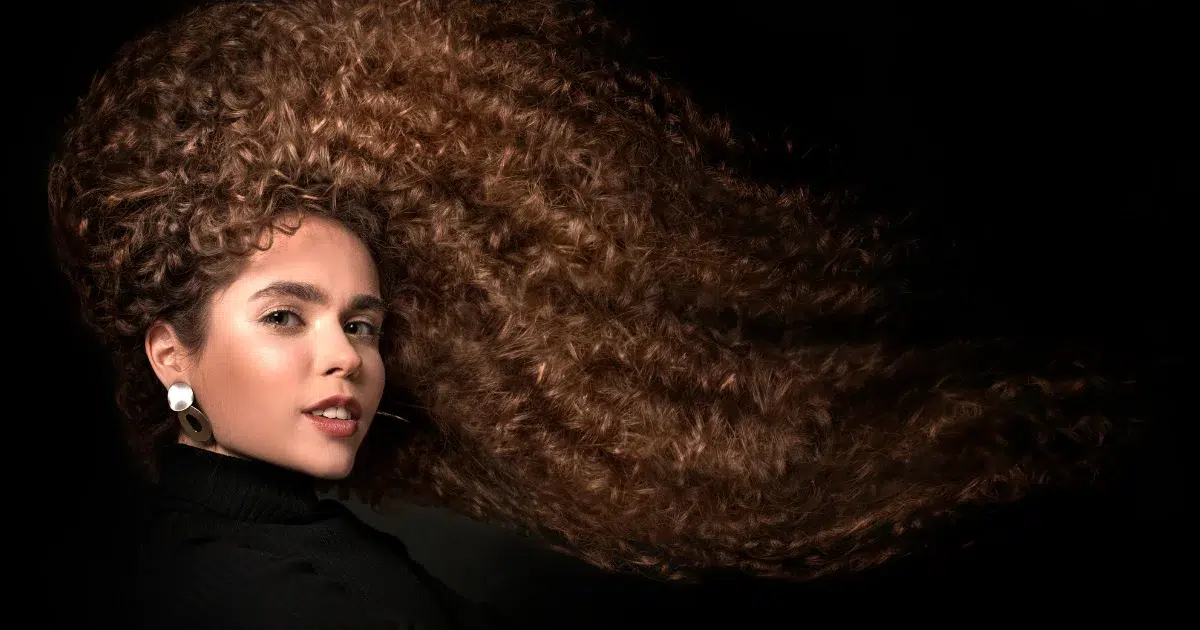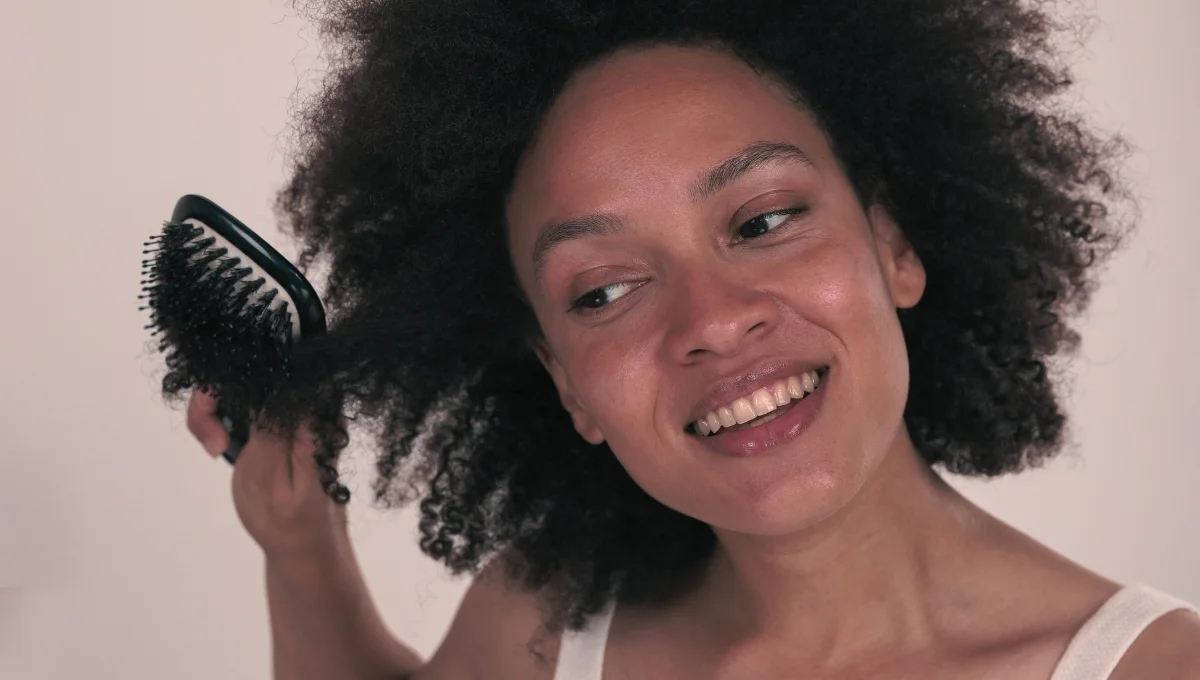
Is protein good for low porosity hair? – the questions we often get in our DMs. The answer is yes, it is.
Does your hair seem to repel moisture, take forever to dry, and struggle to hold styles? You might have low porosity hair!
Many of us know the importance of protein for overall health, and hair is no exception. But when it comes to low porosity hair, which has its own set of challenges, information can get confusing. Can protein actually be helpful, or should you avoid it altogether?
In this guide, we’ll explore everything you need to know about low porosity hair and protein treatments and, most importantly, how to care for it for optimal health and style.
What is low porosity hair?
As we are talking about low hair porosity, you already might have an idea about hair’s porosity. Still, before we delve into the world of protein treatments for low porosity hair, let’s first establish a clear understanding of what low porosity hair truly is.
Hair porosity is the ability of your hair strands to absorb and retain moisture. The hair cuticle, the outermost layer of your hair that acts like shingles on a roof and controls how much water and products can pass through, largely determines this. Understanding Low Porosity Hair
There are three main types of hair porosity–
High Porosity
Cuticles are wide open, allowing moisture to enter quickly but also escape easily, often leading to dryness and frizz.
Medium Porosity
Cuticles are neither too tightly closed nor too open and can easily absorb and retain moisture without excessive buildup. It’s considered well-balanced and generally healthy.
Low Porosity
Cuticles are tightly closed, making it challenging for moisture and products to penetrate the hair. This can lead to several characteristics, including:
- Dryness and lack of shine: The hair struggles to retain moisture, giving it a dull, dehydrated appearance.
- Difficulty holding styles: The closed cuticles make it harder for styling products to adhere, leading to styles that fall flat or need to hold their shape better.
- Frizz and lack of definition: Low porosity hair is more prone to frizz because of the lack of moisture and difficulty absorbing styling products that define curls or waves.
While low porosity hair can present unique challenges, understanding its characteristics is the first step towards creating an effective hair care routine.
How do you know if you have low porosity hair?

Determining your hair’s porosity level is essential for establishing a proper hair care routine that addresses its specific needs. The Strand test is the most popular and simple way of assessing hair’s porosity. Here’s how it’s done–
- Wash a clean strand of hair thoroughly to remove any products.
- Fill a clear glass with room-temperature water.
- Gently place the hair strand in the water and observe.
- Low porosity: The hair floats for several minutes or even hours.
- High porosity: The hair sinks immediately or within seconds.
- Medium porosity: The hair sinks slowly, taking a few seconds to reach the bottom.
While the strand test is often mentioned, it’s important to understand its limitations. Observing your hair’s behavior and characteristics is a more reliable way to identify low porosity. Here are some key signs to look for–
-
Difficulty absorbing water
Does your hair take a long time to get wet in the shower, even when you directly target it with water flow? This could indicate low porosity, as the water struggles to penetrate the hair shaft.
-
Product build-up
Do styling products or leave-in conditioners tend to sit on top of your hair instead of being absorbed? This can happen because the tightly closed cuticles prevent products from fully penetrating the hair.
-
Dryness and lack of shine
Does your hair often feel dry and lack a healthy shine, even after conditioning? This is a common characteristic of low porosity hair due to its challenges with moisture retention.
-
Difficulty holding styles
Do your curls or waves fall flat quickly, or do you struggle with them to hold their shape? This can be a sign of low porosity, as the hair struggles to retain the structure created by styling products.
-
Frizz and lack of definition
Is your hair prone to frizz, even in humid environments? Do your curls or waves lack definition and appear undefined? This can be another indicator of low porosity, as the hair struggles to retain moisture and styling products.
How do protein treatments benefit Low Porosity Hair?
When it comes to hair with low porosity and protein treatments, a common question arises: does low porosity hair actually benefit from protein? The answer is yes. While the tightly closed cuticles of low porosity hair present a challenge, protein offers several advantages. Here are the benefits of protein treatments for low porosity hair–
Strengthening and Repairing
Protein plays a major role in structuring and maintaining the hair shaft’s strength and elasticity. Hair with Low porosity can be prone to breakage due to its dryness and lack of flexibility. Protein treatments can help fill in gaps within the hair, making it stronger and more resilient to damage.
Improved Moisture Retention
While low porosity hair has difficulties absorbing moisture initially, protein treatments can actually help it retain moisture more effectively in the long run. By strengthening the hair structure, protein creates a smoother surface that allows moisture to adhere better and reduces water evaporation.
Enhanced Definition and Volume
Protein treatments can help low porosity hair hold its style better by providing additional structure and definition. This is especially beneficial for people with curly or wavy hair, as protein can help define curls and waves and add volume to the hair.
Understanding the Role of Protein in Hair Health

Before diving deeper into protein applications for low porosity hair, let’s take a step back and understand the fundamental role of protein in overall hair health.
Protein acts as the building block for healthy hair, playing a critical role in its strength, elasticity, and overall structure. Here’s a breakdown of its vital functions–
Building Blocks
- Hair is primarily composed of a protein called keratin.
- Protein consists of amino acids– the major building blocks for keratin production.
- By providing the necessary amino acids, dietary protein supports healthy hair growth and overall hair health.
Strength and Elasticity
- Protein molecules form strong bonds within the hair shaft, making it stronger and more resilient to breakage.
- This is particularly important for low porosity hair, that can be prone to breakage due to its tightly closed cuticles.
- Protein also contributes to hair elasticity, allowing it to stretch and bounce back without snapping.
Repair and Maintenance
- Protein plays a role in repairing damage to the hair shaft caused by various factors like heat styling, chemical treatments, and environmental stressors.
- It helps fill in small gaps and cracks in the hair cuticle, smoothing the surface and improving its overall health.
Moisture Retention
- Protein helps retain moisture within the hair shaft by creating a protective barrier.
- This is especially beneficial for low porosity hair, which often struggles to absorb and retain moisture due to its tightly closed cuticles.
Low Molecular Weight vs. High Molecular Weight Proteins
We’ve established the importance of protein for low-porosity hair, but not all protein types are created equal. Understanding the difference between low molecular weight (LMW) and high molecular weight (HMW) proteins is crucial for choosing the right option for your hair.
Low Molecular Weight (LMW) Proteins
- LMW proteins have smaller molecule sizes, allowing them to penetrate the hair cuticle more efficiently, even in low porosity hair.
- This makes them a preferred choice for low porosity hair, as they can deliver their beneficial properties directly to the hair shaft.
- Examples of LMW proteins include hydrolyzed proteins, whey protein, and soy protein.
High Molecular Weight (HMW) Proteins
- HMW proteins have larger molecule sizes and may struggle to penetrate the tightly closed cuticles of low porosity hair.
- It can lead to product build-up on the hair surface, negating the intended benefits.
- However, HMW proteins can be beneficial for high-porosity hair as they can help fill in gaps and strengthen the hair shaft.
- Examples of HMW proteins include keratin, collagen, and wheat protein.
Choosing the right protein treatment for low porosity hair
Selecting the appropriate protein treatment for low porosity hair is crucial for achieving optimal results and maintaining hair health. Let’s explore how to choose the right treatment and optimize its benefits–
Look for LMW protein ingredients.
Prioritize products that list hydrolyzed proteins, amino acids, or other LMW protein sources on their ingredient label.
Lightweight and water-based formulas
Opt for lightweight, water-based formulas that are less likely to weigh down your hair or create build-up on the hair surface.
Avoid heavy ingredients
Steer clear of products containing heavy oils, silicones, or butter, as these can further hinder penetration and clog the cuticles.
Monitor Hair’s Response
Pay attention to how your hair responds to the protein treatment if you notice any signs of protein overload, such as stiffness, dryness, or increased breakage, scale back on the frequency of use or switch to a lighter formula.
Conversely, if your hair feels stronger, smoother, and more manageable after using the treatment, continue incorporating it into your routine as needed.
Types of protein treatments
Protein treatments come in various forms, each offering unique benefits for strengthening and nourishing the hair. Here are some common types of protein treatments to consider–
Deep conditioning masks
- These are concentrated treatments formulated with protein and other beneficial ingredients.
- Apply them to clean damp hair, follow the recommended processing time, and rinse thoroughly.
- Look for masks specifically designed for low porosity hair or containing LMW proteins.
Leave-in conditioners
- These lightweight conditioners often contain a lower concentration of protein compared to masks.
- They offer daily support and can be particularly helpful for low porosity hair due to their ability to provide continuous moisture and manageability.
- Choose leave-in conditioners with LMW proteins and avoid those with heavy oils or silicones that can create build-up.
Protein Hair Masks
- Offer an intense protein treatment, ideal for deeply repairing damaged or weak hair.
- Apply to clean, damp hair and leave on for the recommended time (usually 20-30 minutes) before rinsing thoroughly.
- Use less frequently compared to conditioners, typically once every 2-4 weeks.
Protein Sprays
- These lightweight conditioners often contain a lower concentration of protein compared to masks.
- They offer daily support and can be particularly helpful for low porosity hair due to their ability to provide continuous moisture and manageability.
- Choose leave-in conditioners with LMW proteins and avoid those with heavy oils or silicones that can create build-up.
DIY Protein Treatments
- While DIY options exist, approach them with caution, as incorrect preparation or application can damage your hair.
- Consult a professional or thoroughly research safe ingredients and appropriate methods before attempting DIY protein treatments.
But it’s important to remember there’s no one-size-fits-all solution for protein treatments. Experiment and find what works best for your unique hair and texture.
What products are good for low porosity hair?

While protein is a valuable component, a successful low porosity hair care routine extends beyond just protein treatments. Here are some additional categories of best products for low porosity hair to consider–
Gentle Cleansers
- Low-sulfate or sulfate-free shampoos: These gentler options cleanse the scalp without stripping away natural oils or moisture, which is crucial for low porosity hair.
- Co-washing: This technique involves cleansing the scalp and hair with a conditioner instead of shampoo, providing gentle cleansing while adding moisture.
Deep Moisturizing Conditioners
- Look for conditioners formulated with moisturizing ingredients like–
- Aloe vera: Provides hydration and soothes the scalp.
- Glycerin: Attracts and retains moisture.
- Shea butter: Offers rich moisture and nourishment.
- Opt for water-based formulas that absorb more easily into the hair shaft.
Humectants
- Humectants are ingredients that attract moisture from the air.
- While beneficial for low porosity hair, use them cautiously and in moderation to avoid over-hydration and hygral fatigue, which can lead to frizz and breakage.
- Examples of humectants include– Glycerin, Honey, and Aloe vera.
Clarifying Shampoos
- Use a clarifying shampoo occasionally to remove product build-up that can prevent moisture penetration.
- Overusing clarifying shampoos can strip away natural oils and exacerbate dryness.
- Choose formulas specifically designed for low porosity hair to avoid harsh ingredients.
Leave-in Conditioners and Hair Oils
- Look for lightweight leave-in conditioners formulated for low porosity hair to provide continuous moisture and manageability without weighing down the hair.
- Light hair oils like jojoba or grapeseed oil can be used sparingly to seal in moisture and add shine.
Protein Issues for Low Porosity Hair
While protein offers significant benefits for low porosity hair, it’s crucial to understand potential issues and ensure you’re using it effectively. Here are some key points to consider–
- Protein Overload: Excess protein can lead to stiffness and dryness.
- Product Buildup: The low porosity hair is prone to buildup, hindering protein absorption.
- Moisture Imbalance: Over-reliance on protein without moisture can cause brittleness.
- Choosing Wisely: Opt for light, hydrolyzed proteins suited for low porosity hair.
- Ingredient Sensitivity: Some ingredients may irritate hair with low porosity; be aware of sensitivities.
How to care for low porosity hair?
Caring for low porosity hair requires a gentle yet effective approach to ensure that it remains healthy, hydrated, and manageable. Here are some essential tips for caring for low porosity hair–
- Clarify: Use a deep cleaning shampoo to remove buildup from old products.
- Moisturize: Use light oils, such as water-based products, lightweight gels, milk or spray leave-in conditioners, or curl cleansing shampoos.
- Use heat: Heat opens up the hair’s cuticles, which allows moisture to penetrate the core of the hair strands.
- Steam: Steam opens up the cuticle, allowing moisture to penetrate the core of the hair strands.
- Avoid protein: Low porosity hair is protein-sensitive, so adding additional protein can cause the hair to become stiff and fragile.
- Avoid heavy products: Heavy hair products can be tough for low porosity hair to absorb. You can also avoid applying too much product or thick, cream-based products.
- Use humectants: Use humectants, such as glycerin, hyaluronic acid, or honey.
- Use a pre-poo: A pre-shampoo (pre-poo) treatment can help make the process of moisturizing low porosity hair easier.
- Dilute your conditioner: Before using your conditioner, try diluting it with some water when you apply it directly to your hair.
- Weekly deep-conditioning: Implement a weekly deep-conditioning treatment to keep low porosity hair moisturized and nourished.
- Residue-Free Products: Choose products that won’t leave behind much residue on low porosity hair.
How often should you wash low porosity hair?
Low porosity hair benefits from less frequent washing compared to other hair types due to its tightly closed cuticles, which limit water and product absorption. However, determining the ideal washing frequency is individual and depends on several factors–
- Scalp Oiliness: Wash more often if your scalp is oily but less if it’s dry to prevent further dryness.
- Activity Level: If you’re active or sweat heavily, consider washing more frequently to remove sweat and buildup.
- Product Buildup: Wash when you notice buildup. Usually, it is every few days to once a week to maintain hair health.
- Experiment: Start with washing every few days and adjust based on your hair’s response.
- Dry Shampoo: Use dry shampoo between washes to refresh low porosity hair without stripping moisture.
Conclusion
Understanding your low porosity hair empowers you to create a personalized routine for healthy, vibrant strands. While the question arises, “Is protein good for low porosity hair?”, the answer is yes, but with specific considerations. Choose low molecular weight protein options for better absorption within the tightly closed cuticles.
Salon Essentials offers diverse products for all hair types and colors. Explore our collection to achieve your hair care goals. We can help you find the perfect products regardless of your hair type or texture.
FAQ
-
What does low porosity hair look like?
Low porosity hair can appear dry, dull, and prone to frizz. It may also be difficult to style and hold onto moisture.
-
How often to do protein treatment on low porosity hair?
For low porosity hair, it’s best to do protein treatments once every 4-6 weeks to avoid protein overload, which can make the hair stiff and fragile.
-
How to moisturize low porosity hair?
Use water-based products with humectants (like glycerin) to attract and retain moisture. Deep condition regularly and consider steam treatments to enhance product absorption.
-
What does low porosity hair need?
Low porosity hair needs moisture and gentle care. Choose lightweight products that penetrate easily and avoid harsh chemicals or excessive heat styling.

